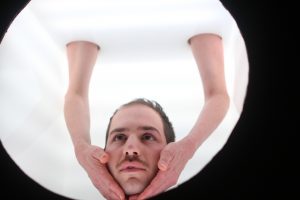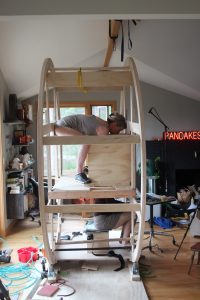Michelle Ellsworth uses her expansive definition of dance as well as video, text, performance sculptures, and the World Wide Web to explore topics ranging from pharmaceutical art to experimental surveillance. Consistently commingling with technology and objects, her recent innovative works were highlighted in the New York Times’ article Best of Dance 2015 under the heading “Dances With Gadgets.” Among her honors are a Guggenheim Fellowship (2016), Doris Duke Impact Award (2015), a NEFA National Dance Project Grant (2014), a Creative Capital Fellowship (2013), and a USA Artists Knight Fellowship in Dance (2012). She has received three National Performance Network Creation Fund Commissions (2004, 2007, and 2016). Highlights in her performing career include presenting at The Chocolate Factory, On The Boards, Danspace, Diverseworks, and also at the Noorderzon, Contemporary Latitudes, Fusebox, and TBA Festivals.
She spoke with Miriam Felton-Dansky about her work in progress for We’re Watching, titled The Rehearsal Artist.
Miriam Felton Dansky: Tell me about the inspiration for The Rehearsal Artist.
Michelle Ellsworth: The piece that precedes this was called Clytigation. For that work I remixed Aeschylus’ Oresteia and looked at how the Trojan War impacted the legal protocols that appear at the end of the Oresteia, when Athena sets up the first ever murder trial, and how profound that was for the legal system. I was looking at post-9/11 conditions, and how legal protocols shifted after that with regard to the use of drones, surveillance, torture, and the suspension of habeas corpus. Italian philosopher Giorgio Agamben’s work State of Exception (2004) as well as American philosopher Judith Butler’s Frames of War: When is Life Grievable? (2009) and Precarious Life: The Powers of Mourning and Violence (2004) came up for me. Some of these ideas from Clytigation have lingered and become part of The Rehearsal Artist. I have kept reading and trying to create a kind of kinaesthetic replica of what I’m feeling, seeing, and thinking about in the geopolitical world and my personal experience …specifically about watching and being watched.
This larger thinking about surveillance came up against my experience with being watched as a performer. I have this recurring thing that happens to me as an artist, which is that I like to make work but I have a profound resistance to performing it. I started thinking, maybe there is a loophole where I could use the idea of “remote sensing,” which allows you to get information about a subject without touching it. Does everybody know what remote sensing is?
MFD: I don’t. Could you explain?

ME: The military uses it. It’s the acquisition of information without being on site. You can shoot a beam at something and then the data comes back to you—like sonar. So I thought if I could get more distance from the audience, or if I could not know when they were collecting my “data,” I would feel more comfortable. So, my lack of comfort in performing was colliding with this practice of remote sensing by the military, and the whole idea of knowing something from a distance. Then I started thinking about the relationship of performance to social science experiments, and that’s what took me to the observation of performers or “subjects through one-way glass, and the role of the audience as a practitioner of surveillance. This one-way transmission amplifies the surveillance aspect but also insulates the performer from the presence of the audience.
MFD: How did you start creating the piece?
ME: I started with this awareness that I needed the ability to rotate around the axis of my nose—because that kind of disorientation seemed important. I talked to designer Bruce Miller, who said: “Oh, you need a giant wheel, and then you can rotate around the axis of your nose.” In my mind, the performers are like participants in an experiment. The language of science resonates for me: if I keep changing the variables in each performance, then I’m collecting different their data. I call each run through of the work a “hypothohearsal,” because they are half experiments and half rehearsals. So there’s the one-way glass, and this giant wheel, and the dancer’s head in isolation. The performer or the “subject” doesn’t have a sense of the audience at all, they’re just looking at themselves through this one-way glass. I did a bunch of experiments a few weeks ago where I put twenty-two people in the wheel and the documentation of those experiments will be installed in the Fisher Center lobby.
MFD: So, is each iteration of the piece different?
ME: Yes. For the version that will be on display in the lobby, I had a consistent score, however in the space I will be working on different subjects, and I will have many options. We’ll do it 48 times, and there will be 48 different versions of the piece.
MFD: Thinking about this as an experiment, does the audience come away with some kind of conclusion, or with information gathered?

Photo by Satchel Spencer.
ME: I don’t have any ambition as to how this piece reads to the audience. The art I find myself most responsive to is work that shifts my perspective or that helps me to reconsider, even ever so humbly or mildly, something that I had already filed on the shelf called “I got that.” If I did have an ambition it would be that. But it could just be about the experience of watching the dancer. I was never that great executer of turns as a dancer. I could never do more than two, maybe three pirouettes. But now when I turn in the wheel, I’m like “woohoo, I’m turning now… I’m a turning dancer!” It can be visual, it can be geopolitical, and there are other components. I’m definitely also working on the absence of my father from the planet, I think sometimes The Rehearsal Artist is all a death practice. When I’m in the head box it definitely feels like death practice. Whether that’s legible in any way, I don’t know.
MFD: I’m wondering whether the physical space of the Fisher Center has influenced the way you have thought about constructing the piece.
ME: I wouldn’t say the architecture, nearly as much as the generosity and the attention of the Fisher Center team and their philosophical commitment to supporting work…that has been profound. It’s been the house of “yes,” and for a premiere and an early iteration that has been really helpful.
Miriam Felton-Dansky is a professor in Bard’s Theater & Performance Program.
To find out more and to purchase tickets click here.
Watch the trailer for The Rehearsal Artist: